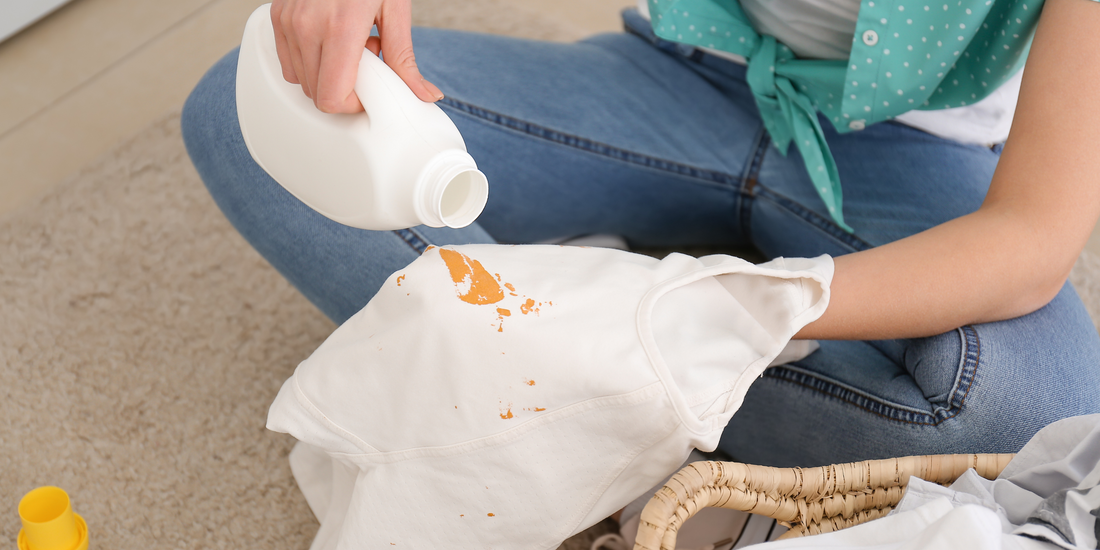
There is certainly no shortage of hacks for erasing fabric stains. From baby powder to soak up butter from your shirt or acetone to remove water-based paint splatters on a pair of overalls, methods like these can help save those clothes from ruin. For everyday smudges and lightly soiled items, however, a commercial pretreatment product is the best tool to have handy in the laundry room. The job of a pretreatment stain remover product is to break down the molecules while in the wash, so the job gets done the first time around. Once a garment goes through the washing machine and dries, the stain becomes much more difficult, if not impossible, to remove.
To discover the best pretreating methods, we enlisted the help of Mary Gagliardi, otherwise known as Dr. Laundry, the in-house scientist and cleaning expert for Clorox. “Pretreating has always been a great technique to get stains out,” she says. “And now that so many clothes washers bounce or tumble laundry in and out of the wash solution instead of submerging clothing in it for the entire cycle, pretreating has become even more important to removing stains." To avoid permanent stains that might force you to throw out some of your favorite pieces of clothing, follow this practical guide for pretreating your laundry.
When to Pretreat Stains
Working on stains as quickly as possible is the best way to eliminate them. “The most effective pretreaters can't be left on fabric indefinitely, so it's best to apply them shortly before washing the stained item," Gagliardi says. She explains that manufacturers have different standards for how long the product should sit before being tossed in the wash, so always double-check the directions before beginning.
If you don’t have the time to run a load of laundry soon after a stain occurs, you can still take steps to prevent it from setting in. Gagliardi suggests rinsing, blotting, or scraping the stain away until you can pretreat it. For tricky stains, like grease or oil, sprinkle on an absorbent powder (like baby powder, baking soda, cornstarch, or cornmeal) to soak up the moisture until you can tackle it properly.
For heavily soiled items, you might want to perform a prewash soak. In this case, add the item to a basin with water and a bit of pretreatment product. Let the item soak for anywhere from 30 minutes to overnight (depending on the product's instructions) before laundering it as usual. If you can't get to the stain for a while, keep the garment separate from the rest of your dirty laundry and in plain sight so you don’t forget to pretreat it before tossing it in the washer.
Consider the Type of Stain
“Effective pretreatment methods vary by stain type,” Gagliardi says. “What works for one stain won't always be helpful for another.” She describes the challenge of dealing with a combination of stains, such as oil and color. For example, you can rinse a red wine stain with water or club soda to reduce its potency before pretreating and washing it. But if you’re working with a pigmented stain that also contains an oily component, like lipstick smears, that method should be avoided because oil repels water. Instead, Gagliardi advises pretreating a stain like this by first rubbing it with a mild detergent, such as Dawn dish soap, rinsing it thoroughly after a few minutes, and then applying your go-to pretreatment product.
Dye-based stains like ink can benefit from being blotted with rubbing alcohol before pretreatment. Other types of stains are sensitive to temperature—heat can cause protein-based stains like sweat to set, so try rinsing or soaking them in cold water before applying the pretreatment. Regardless of the type of stain, however, Gagliardi explains that pretreating is especially vital for stained items that need to go through the cold water wash cycle. Since cold water might not fully break down stains on its own, you have a better chance of removing them using pretreatment.
How to Pretreat Laundry Items
While pretreatment can sound tricky due to factors surrounding the timing and type of stain, the overall process is simple. Use this guide to take the guesswork out of pretreating your clothes and keeping them looking like new.
Step 1: Identify the Stain Type
Determine if the stain was caused by oil, grease, ink, dye, tannins, protein, or a combination so you can figure out what to do and what to avoid.
Step 2: Reduce the Stain Immediately
Even if you’re not home and, therefore, can’t apply a pretreatment just yet, take the following steps to get a head start on minimizing the stain.
- Gently scrape loosened pieces off the fabric, such as dirt, grass, or food.
- Blot (never rub!) the stain with a clean cloth or paper towel to remove as much excess liquid and color as possible.
- Rinse the area around the stain with the appropriate water temperature and blot dry. Alternatively, you can use a stain remover stick or wipe if it’s safe for the material and type of stain.
Step 3: Apply the Pretreatment
For the best chance of eliminating the stain, pretreat and wash the item immediately. Following the label instructions, apply the pretreatment to the stain for the recommended time. If you can’t clean the garment right away, put it aside and leave time to pretreat before the next load. For tougher or more pervasive stains, prepare a prewash soak using the pretreatment before adding the item to the washer.
Step 4: Rinse and Wash
Rinse the pretreated area of the item under cold running water and then wash it as usual.
Step 5: Reassess the Stain Before Drying
Check the item for any lingering discoloration as soon as you remove it from the washing machine. Heat will set in stains, so you don't want to run it through the dryer if it doesn’t come out completely during the wash cycle. Instead, try pretreating and washing it a second time. Also, while it might look like an oily or greasy stain is visibly gone, some could still be embedded in the fibers, creating a fire hazard. Always air-dry anything you wash that has come in contact with flammable substances.
Source: Cornetta, M. (2025j, June 6). How to pretreat laundry stains for spotless results every time. Better Homes & Gardens. https://www.bhg.com/pretreat-laundry-guide-8753524


